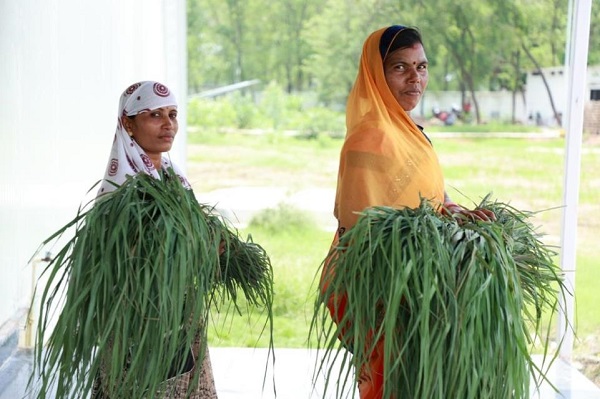Bijapur, (Samajweekly) Bhawani Pal Shah was among the first graduates in his remote village in Chattisgarh. He passed out in 2000 – the year the state was formed – and went looking for greener pastures in Rajasthan. After fifteen years of working in an agri firm there, he decided to return to his village, Gudma in Bijapur district, and take up farming. This was a better alternative, he thought, to sweating it out in the desert state. Besides, at his job, he had learnt about modern farming techniques for better yields that could be practised at his farm.
Shah faced little success with paddy, which is predominantly grown in the state, as it requires a lot of water. So it could only be cultivated during the Kharif season at the onset of the monsoon. However, not one to throw in the towel, he started to look out for other crops that would provide better outputs and income.
In 2019, Shah visited the Raipur Indira Gandhi Krishi Vishwavidyalaya at Raipur and learnt about the cultivation of lemongrass – an aromatic plant whose Indian variety is scientifically known as Cymbopogan flexuosus. Lemongrass is used in soaps and detergents, perfumes, beverages and incense sticks. According to the National Horticulture Board, the oil’s strong lemon-like odour is also used in insect repellents. Lemongrass oil fetches around Rs 1,550 per litre.
“The oil and leaves of lemongrass are also used for medicinal purpose. It reduces inflammation, blood sugar, convulsions, pains and joint aches etc,” said Dr Arun Sakni, a senior scientist at Krishi Vigyan Kendra Bijapur, leading the government’s effort to encourage lemongrass cultivation in Bijapur.
“I took a few hundred saplings and grew it on my half acre land and was delighted with the results. This year I am going to sow lemongrass on three acres of land,” Shah said.
The only thing lacking is a solar pump for irrigation purpose. “I am hopeful the district Agriculture Department will sanction it,” he said.
Shah, who extracted 7 kilograms of lemongrass through a self-made processing unit, said, “We can get a processing unit sanctioned by Central Institute of Medicinal and Aromatic Plants (CIMAP) if more than 10 acres of land or more than 10 farmers are into lemongrass cultivation in my area. I am trying to convince farmers,” he said. He has been encouraging villagers by apprising them of line sowing, transplantation and other modern techniques to get more yield. CIMAP has appreciated Shah’s leadership efforts.
Dr Sakni said that they are planning to form a group of interested farmers to promote lemongrass farming in the district and Shah would act as a master trainer and motivator. “With 80 per cent of the area covered by forests, lemongrass can be a great change-maker in the lives of people who are mostly tribals. It doesn’t need much water nor hard labour. Just a spray of water to keep the soil moist. And once planted, its sapling regenerates thrice in a year,” he said.
Replicating the success of neighbours
Bijapur was carved out of Dantewada district which was a part of Bastar district – a region plagued by Naxalism. In addition to the hostile weather, farmers here also have to contend with the challenges posed by Naxals where their diktats extend even to the area of cultivation.
In a bid to wean away jobless youth from taking to violence in the Naxal-infested region, the CIMAP provided training to youth to cultivate lemongrass and oil extractors. The initiative was taken under the direction of the central government’s ‘Aroma Mission’, launched by the Council of Scientific and Industrial Research.
In Kondagoan district, some 200 kilometres from Bijapur, lemongrass farming has seen a steep increase. The CIMAP has set up three processing units in the Malegaon area of Kondagoan.
Shah’s friend, Mohan Ram Netam, a farmer in Malegaon village said, “It is much profitable than paddy. One acre of lemongrass cultivation fetches between Rs 40,000-45,000.” He said the rates keep varying between Rs 1300 to Rs 2000. “Last year we sold at Rs 1,500 per kg and this year at Rs 1,375.” At present, there are 25-30 farmers in Malegaon who are now dedicated lemongrass farmers, said Netam.
“One sapling reproduces some 100 saplings. The process continues thrice a year. In some cases, the saplings keep reproducing for two to three years depending upon the soil fertility. Though our land is suitable for lemongrass, we also planted Mentha grass which is another variety of aromatic plant,” he said.
Another 100 kilometres towards the north of Kondagoan lies Dhamtari, a district in Central Chhattisgarh. Lemongrass farming in this district has reached the next level with the support of the district administration. The Zila Panchayat has promoted a Self Help Group (SHG) – Jai Bhawani – to cultivate lemongrass. It extracted 15 quintals of lemongrass from 3 acres of land fetching an income of Rs 50,000.
Three acres of wasteland in Gram Panchayat Bhatgaon were turned into a cultivable land with the help of MGNREGA using the convergence model between Departments of Chhattisgarh State Renewable Energy Development Agency, Horticulture and MGNREGA, according to a District Panchayat Program Officer.
Once the administration is able to get lemongrass cultivation off the ground, the next issue they would need to tackle is marketing. Already, farmers like Netam are finding this problematic. “With no government support, we have to sell it to private contractors who often short charge us,” he said.
(The author is a Bijapur-based freelance journalist and a member of 101Reporters.com, a pan-India network of grassroots reporters)










